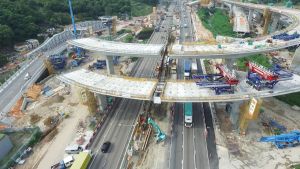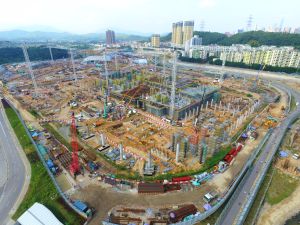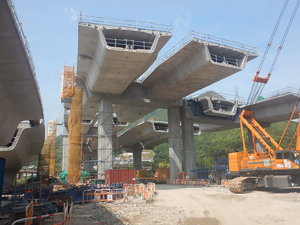|
When travelling on Fanling Highway near Kau Lung Hang, have you noticed the large-scale bridgeworks under active construction at the road side? These bridges are in fact part of the Liantang/Heung Yuen Wai Boundary Control Point (LT/HYW BCP) project.
The LT/HYW BCP will be the seventh land-based BCP between Hong Kong and Shenzhen. At present, there are two land-based BCPs at Man Kam To and Sha Tau Kok on the eastern side of Hong Kong. Owing to geographical constraints, however, these two BCPs have little room for further expansion. Situated between Man Kam To and Sha Tau Kok, the LT/HYW BCP will make up for the inadequacies and make cross-boundary transportation and connections between Hong Kong and the eastern part of Guangdong Province as well as the Fujian and Jiangxi Provinces more convenient and efficient. In future, we need not travel through the hectic urban areas in Shenzhen to reach the Chaoshan and Fujian areas. This will greatly reduce the journey time. Within the Hong Kong territory, the new BCP will be connected with expressways. We will not have to travel through the busy roads in Fanling and Sheung Shui to visit Shenzhen, thereby significantly shortening the travelling time within Hong Kong as well. In addition, upon completion of the new BCP, the cross-boundary passengers and vehicular flows will be re-distributed and the busy condition at the existing BCPs will be alleviated. This can help expand Hong Kong’s economic hinterland and strengthen our position in the development of the Pearl River Delta region. The connecting road of the BCP can also alleviate the traffic congestion around Sha Tau Kok Road, which will facilitate the access of local residents and the long-term development of the area.
The LT/HYW BCP is a technically challenging mega infrastructure project comprising the construction of a connecting road, a passenger terminal building and cross-boundary bridges. The 11 kilometres (km) long connecting road of the BCP includes 5.7 km of tunnels, 4.3 km of viaducts and 1 km of at-grade roads. Among them, the 4.8 km long Lung Shan Tunnel will be the longest land-based road tunnel in Hong Kong upon completion, which will be 0.8 km longer than the Tate’s Cairn Tunnel – the longest tunnel in the territory at present. The tunnel passes through complicated underground strata, and advanced tunnel boring techniques have been employed in most of the works to minimise the effect on residents. The tunnel boring machine has a diameter of 14.1 metres or is about four-storey high, which is the second largest ever used in Hong Kong. More than 4 000 precast concrete units, each weighing around 70 tonnes, have to be made for the construction of the 4.3 km long viaducts. Given the large number of precast units involved, the entire production, transportation, lifting and installation processes require extremely precise and thorough arrangements, which allow no leeway for error. In addition, some of the viaducts at the Fanling Highway Interchange, which is now under construction, have to be built over the existing Mass Transit Railway (MTR) East Rail Line. To ensure construction and railway safety, the project team has been maintaining close liaison with the MTR Corporation Limited. Lifting and installation of precast units on every occasion has to be completed within a tight working window of three hours after the railway has ceased operation at night. One can well imagine the enormity of the challenges of these works.
Needless to say, during the implementation of such a major project, there would inevitably be some disruption to the local residents. To mitigate the impact, the project team has often been in close contact with the residents in the vicinity of the construction area. Take Chuk Yuen Village in Ta Kwu Ling as an example. As it was situated within the BCP area, the Government had to relocate the whole village and resume the land for the construction works. To minimise disturbance to eligible villagers, we need to have a thorough understanding of their concerns and needs. As such, the project team visited the village door to door and met the residents on a number of occasions to explain to them the land resumption arrangements and engage them in discussions on the entire relocation process. As a result, despite some twists and turns, relocation of Chuk Yuen village was completed smoothly in September 2014. The project team has still maintained communication with the residents even after the relocation to listen to their views on the construction works so as to minimise the inconvenience caused to them.
Construction works for the BCP and the connecting road have commenced in phases since 2013. Although there have been quite a number of obstacles, such as the obstruction encountered during the funding applications in the Legislative Council, we were not at all daunted but tried our best to overcome the difficulties. Now, all the works contracts have been awarded. The construction progress and expenditure are both in line with our expectations. The piling works for the foundations of the passenger terminal building and other buildings have also been completed recently, and the superstructure construction has already been launched. Besides, nearly half of the assembly works for the viaducts at the Fanling Highway Interchange have been completed. When you pass through the Fanling Highway, you can see the overall layout of the viaducts. Tunnel boring and blasting works for the Lung Shan Tunnel have also reached the peak of activity.
The project teams of the Civil Engineering and Development Department and the Architectural Services Department are striving to complete all the works by the end of 2018, so as to enable the public and tourists to use the new BCP that is directly accessible by both pedestrians and vehicles at an early date.
|
|
|
|
| Construction of viaducts over the Fanling Highway |
 |
| Construction of viaducts over the Fanling Highway |
 |
| Construction of the Liantang/Heung Yuen Wai Boundary Control Point (LT/HYW BCP) |
 |
| Viaducts of the connecting road of the LT/HYW BCP |
|